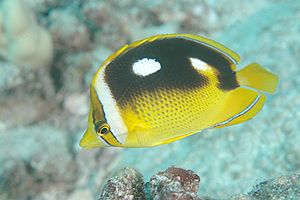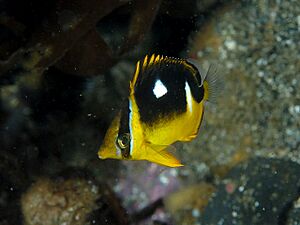Fourspot butterflyfish facts for kids
Quick facts for kids Fourspot butterflyfish |
|
|---|---|
 |
|
| Conservation status | |
| Scientific classification | |
| Genus: |
Chaetodon
|
| Species: |
quadrimaculatus
|
| Synonyms | |
|
Heterochaetodon lepidochaetodon quadrimaculatus (Gray, 1831) |
|
The four-spotted butterflyfish (Chaetodon quadrimaculatus) is a colorful species of butterflyfish. It belongs to the family Chaetodontidae. You can find this fish in the Pacific Ocean. Its home ranges from the Ryūkyū Islands and Taiwan to the Hawaiian Islands. It also lives near the Marquesas Islands and Pitcairn Islands. Further south, it is found near Samoa and the Austral Islands. In Micronesia, it lives around the Mariana Islands and Marshall Islands.
This butterflyfish eats mostly coral. This means where the fish lives depends on where corals grow. More corals usually mean more four-spotted butterflyfish.
It is a unique fish, but it is most like the speckled butterflyfish (C. citrinellus). Scientists study how these fish are related to other butterflyfish.
Many butterflyfish are popular in home aquariums. Their bright colors and patterns make them special. They are a small but important part of the global fish trade.
Contents
What Does This Fish Look Like?
The four-spotted butterflyfish is one of about 90 species in the Chaetodon group. These fish have a flat body that is the same on both sides. They have scales with comb-like edges.
A key feature of this fish is its four round, eye-shaped spots. There are two spots on each side of its body. Scientists think these spots help the fish stay safe from predators. The spots might scare away enemies. Or, they might make predators attack a less important part of the fish's body.
What Do Four-Spotted Butterflyfish Eat?
The four-spotted butterflyfish eats only hard corals. This special diet likely developed millions of years ago. These fish depend a lot on scleractinian corals. These corals are often called stony corals. About half of them help build coral reefs.
Butterflyfish usually feed on corals by gently picking off small parts. They use the tips of their upper and lower jaws to grab the coral polyps. They do not harm the hard coral skeleton. Because they only eat corals, these fish are very good at feeding. They bite the coral more often than other butterflyfish that eat different things.
How Do These Fish Live Together?
Since four-spotted butterflyfish rely on corals for food, they often live in stable areas. They tend to stay in the same feeding spots. Adult fish usually live in pairs. Young fish are often found alone.
Sometimes, scientists have seen other types of pairs in this fish group. This suggests that living in pairs might offer more than just helping with reproduction. For example, being in a pair can help them find food better. It can also help them watch out for predators.
In male and female pairs, the male fish often protects their home area. This allows the female to find food more easily. This helps her produce more eggs.
Life Cycle and Reproduction
Four-spotted butterflyfish usually reproduce in pairs. They release their eggs and sperm into the water. This is called spawn breeding. The eggs are very tiny, less than 1 millimeter. Fertilized eggs hatch in about 30 hours.
Like other butterflyfish, the four-spotted butterflyfish has a special larval stage. This stage is called tholichthys. During this time, the larva's head is covered by fused plates. This gives it a unique spiky head.
After hatching, the young fish settle directly onto corals. The corals offer them protection from other fish. There is little to no parental care for the young fish.
Conservation
Four-spotted butterflyfish are closely linked to stony corals. This means they can show how healthy a coral reef is. If there are many of these fish, the reef is likely healthy. If their numbers drop, it could mean the corals are in trouble.
Recent changes in global climate, like warmer ocean temperatures, have caused problems. For example, in 2015-2016, there was a big coral bleaching event. This happened in the central Indo-Pacific. Coral bleaching means corals lose their color and can die. This event likely reduced the food available for these butterflyfish.
Research shows that coral bleaching can make butterflyfish less aggressive. It can also affect their growth and how many young they produce. Even if the fish population doesn't drop right away, these long-term effects are important.
See also
 In Spanish: Pez mariposa de cuatro manchas para niños
In Spanish: Pez mariposa de cuatro manchas para niños



